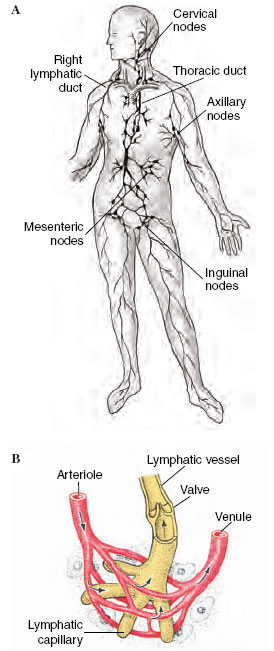Lymphatic System
Lymphatic System
The lymphatic system of vertebrates is an extensive network of thin-walled vessels that arise as blind-ended lymph capillaries in most tissues of the body. These unite to form a treelike structure of increasingly larger lymph vessels, which finally drain into veins in the lower neck (Figure 33-18). A principal function of the lymphatic system is to return to the blood the excess fluid (lymph) filtered across capillary walls into interstitial spaces. Lymph is similar to plasma but has a much lower concentration of protein. Large molecules, especially fats absorbed from the gut, also reach the circulatory system by way of the lymphatic system. The rate of lymph flow is very low, a minute fraction of blood flow.
The lymphatic system also plays a central role in the body’s defenses. Located at intervals along the lymph vessels are lymph nodes (Figure 33-18) that have several defenserelated functions. Cells in the lymph glands such as macrophages remove foreign particles, especially bacteria, which might otherwise enter the general circulation. They are also centers (together with bone marrow and thymus gland) for production, maintenance, and distribution of lymphocytes that produce antibodies— essential components of the body’s defense mechanisms
 |
| Figure 33-18 Human lymphatic system, showing major vessels, A, and a detail of the blood and lymphatic capillaries, B. |
The lymphatic system of vertebrates is an extensive network of thin-walled vessels that arise as blind-ended lymph capillaries in most tissues of the body. These unite to form a treelike structure of increasingly larger lymph vessels, which finally drain into veins in the lower neck (Figure 33-18). A principal function of the lymphatic system is to return to the blood the excess fluid (lymph) filtered across capillary walls into interstitial spaces. Lymph is similar to plasma but has a much lower concentration of protein. Large molecules, especially fats absorbed from the gut, also reach the circulatory system by way of the lymphatic system. The rate of lymph flow is very low, a minute fraction of blood flow.
The lymphatic system also plays a central role in the body’s defenses. Located at intervals along the lymph vessels are lymph nodes (Figure 33-18) that have several defenserelated functions. Cells in the lymph glands such as macrophages remove foreign particles, especially bacteria, which might otherwise enter the general circulation. They are also centers (together with bone marrow and thymus gland) for production, maintenance, and distribution of lymphocytes that produce antibodies— essential components of the body’s defense mechanisms




